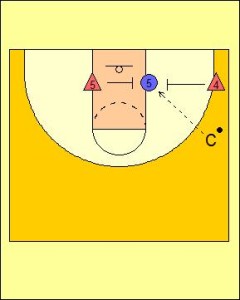Low Post Pass and Go Drill
The Low Post Pass and Go Drill provides a good scenario for players to experience the pressure of finishing a scoring opportunity in quick succession of receiving a pass. The Low Post Pass and Go Drill provides a situation where there are two defenders and only one offensive player. This sees a numbers advantage with the defensive team, but this is balanced by spacing and time for the offensive player to execute a scoring move towards the basket.
Often in many post player focused drills there is an absence of the pressure to create and finish a scoring opportunity as quickly as possible. By comparison, in a game situation if a team’s interior play is effective, the opposition’s defences will attempt to limit this point’s production by doubling the specific post player or employing some other tactic. For this reason once an interior player has developed the necessary technical skills to have a range of post scoring moves. They then need to be exposed to utilising these in more and more game realistic situation. The Low Post Pass and Go Drill does exactly this by allowing only a few moments for the post player to create and make a score before being overrun with multiple defensive players.

The Low Post Pass and Go Drill starts by having an offensive player (Five) placed at the Low Post or Double Block.
There are two defenders within this drill. One starts at the strong side Long Corner (Four) and the other at the weak side Low Post area.
The Coach starts with the ball and on the pass the drill becomes “Live”. The Low Post Pass and Go Drill is a competitive situation and the offensive player will need to react quickly once receiving the ball to execute a score without being caught by two defenders.
The offensive player can either move towards the middle of the floor or to the base line. The performance and utilisation of all offensive moves the post player has should be encouraged. For a player to gain the best outcome from the Low Post Pass and Go Drill they must use the full range of moves they have. By doing this a player will then realise which of their moves and counter moves will be effective in a game.
If the sequence of the Low Post Pass and Go Drill happens as designed the weak side low post player will reach the offensive player first. Therefore, for a very brief moment the Low Post Pass and Go Drill will be one on one in the post. This situation however will not last very long so the offensive player must be decisive in making the right move and quickly.
Variation
If a coach finds their players struggling to make an effective scoring opportunity initially, one option is to delay the reaction of one of the defenders. This can be done by simply starting the player helping from the perimeter must wait for a count of two before moving following the reception of the ball by the offensive player.
Another option is to change the position of the offensive player to the High Post. This maybe a useful variation in helping players develop diversity in their interior scoring options.
Alternatively, an extra offensive player can be added to the Low Post Pass and Go Drill. This player can be placed in any number of different positions on the weak side of the floor waiting for the assist pass from the post player for the uncontested shot.
This situation can be expanded further to have multiple players on the weak side of the floor that cannot move but can be used for catch and shoot purposes. This allows the offensive post player to develop their passing skills.








Leave a Reply